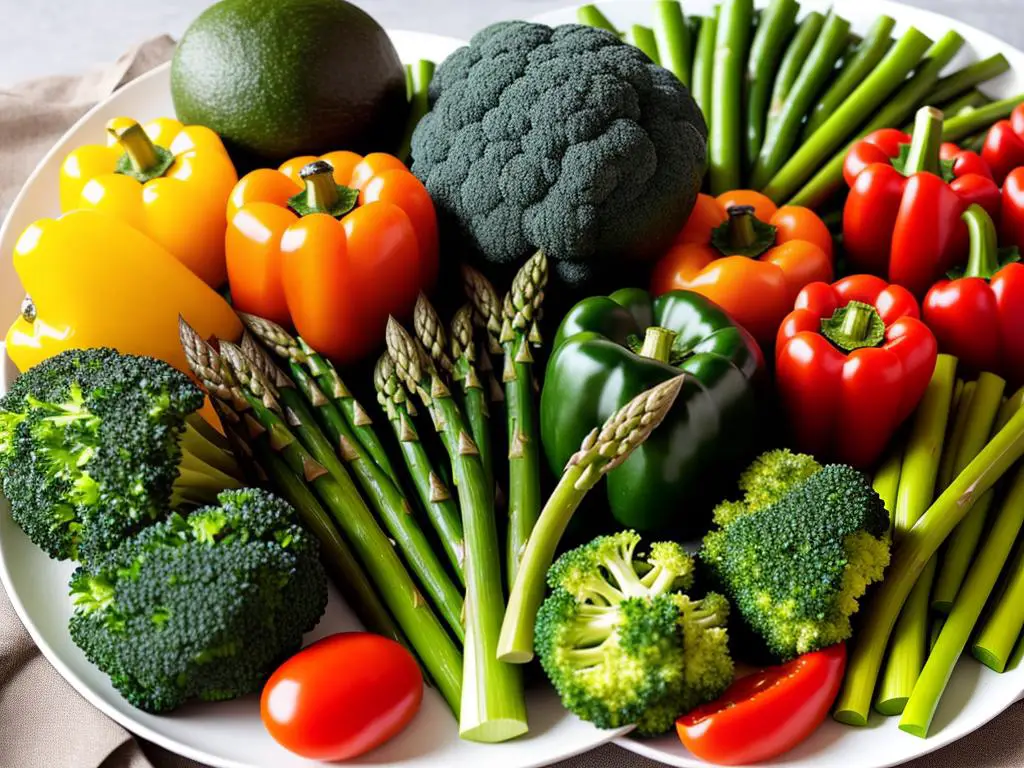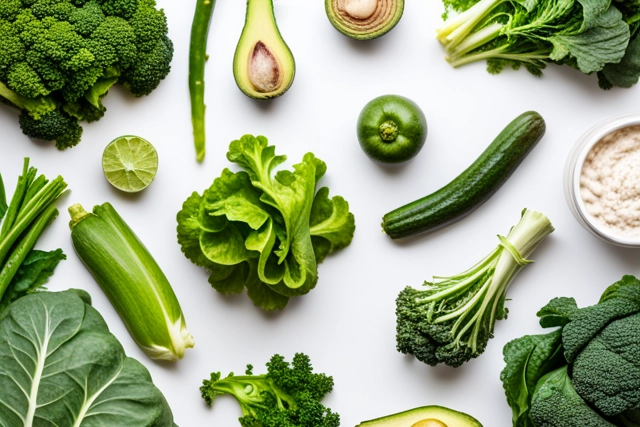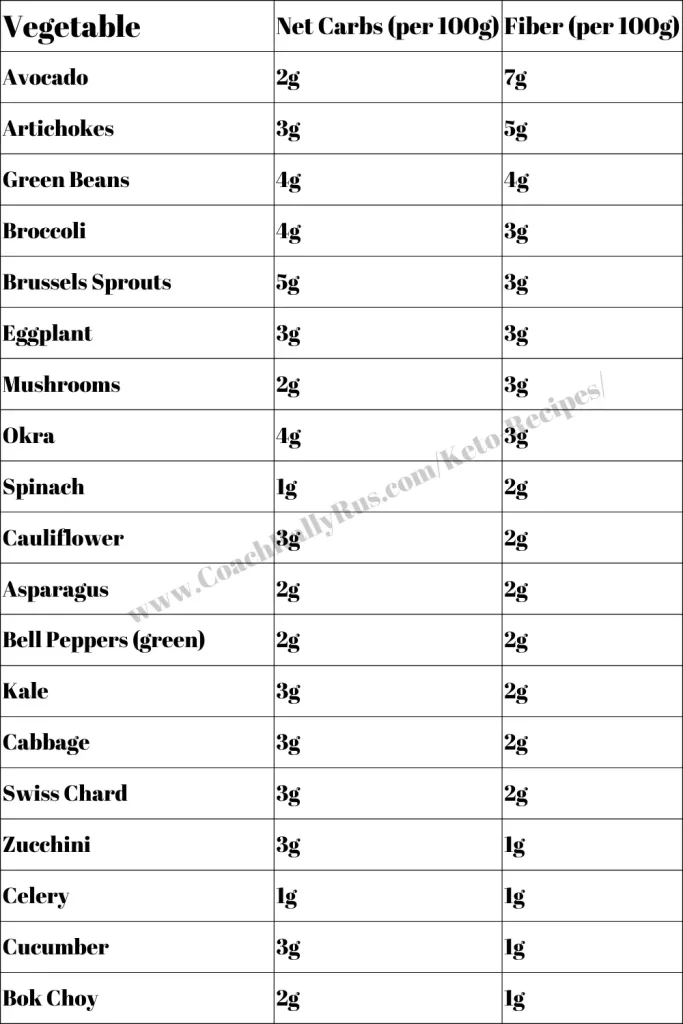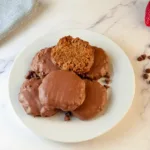The keto diet is popular because it’s good for your health and helps you lose weight. On this diet, your body uses fat instead of carbohydrates for energy. But some people may have trouble getting enough fiber while on this diet. Luckily, there are many high-fiber vegetables that are also low in carbs, which makes them a great choice for people on the keto diet. This guide will explain the keto diet, and the importance of fiber, and give you a long list of vegetables that are good for the keto diet. It will also show you how to easily add these vegetables to your meals and clear up any confusion about this type of diet and eating high-fiber vegetables.
Table of Contents
Understanding the Keto Diet
Understanding the Ketogenic Diet
The Ketogenic or ‘Keto’ diet was originally designed in the 1920s as a treatment for epilepsy, but today, it’s gaining popularity as a rapid weight loss and overall health strategy. The principle behind the keto diet focuses on consuming high fat, moderate protein, and very low carbohydrate foods. By drastically cutting carbohydrates from the diet, the body is forced into a metabolic state called “ketosis.” In ketosis, the body, lacking carbohydrates for energy, starts to burn fat for fuel, which often results in weight loss.
The diet typically consists of approximately 70-75% fats, 20-25% protein, and only 5-10% carbohydrates. Keto dieters usually aim to get less than 50 grams of net carbs (total carbs minus fibre) a day.
Benefits and Risks of the Keto Diet
Research suggests the keto diet can lead to significant weight loss, and it may also be beneficial in managing neurological conditions like epilepsy, Alzheimer’s and Parkinson’s diseases. It can also result in improved heart health due to the reliance on healthy fats for energy.
However, it’s important to note that the keto diet isn’t without risks, and it isn’t suitable for everyone. Potential risks include nutrient deficiencies due to the restricted carb intake and the “keto flu,” a group of symptoms including headache, fatigue, and nausea that some people experience when they first enter ketosis. Always consult with a healthcare professional before starting any diet regimen, including keto.
Role of Carbs, Proteins and Fats
In the keto diet, carbohydrates are minimized, proteins are moderated, and fats are increased to ensure the body adopts fat as its primary source of energy. Common high-fat foods include avocados, cheese, meats, and nuts. Non-starchy vegetables, like leafy greens, provide essential nutrients and are a crucial part of the diet.
Though the diet leans heavily on high-fat foods, it doesn’t mean that all carbohydrates are off the table. High fiber vegetables play an essential role by providing necessary nutrients, while also contributing to satiety and facilitating digestion.
High Fiber Vegetables for Keto
While starchy vegetables like potatoes and carrots are discouraged due to their high carb content, many other vegetables can serve as excellent sources of fiber on a keto diet. Examples include:
- Leafy Greens: Including spinach and kale, are very high in fiber but low in digestible or ‘net’ carbs.
- Zucchini: A type of summer squash is another high-fiber, low-net-carb option.
- Cauliflower: This versatile vegetable can be used in place of rice, mashed potatoes, or even pizza crust.
- Broccoli: It’s high in fiber and low in net carbs, plus it’s packed with vitamins.
- Avocados: Even though technically a fruit, avocados are a keto staple due to their high healthy fat and fiber content.
These high-fiber vegetables normalize bowel movements, lower cholesterol levels, control blood sugar, maintain bowel health and aid in achieving a healthy weight.
When it comes to personalizing a diet plan, responses and results can vary widely across the general public. One popular approach, the ketogenic or ‘keto’ diet, places emphasis on high fat and low carbohydrate intake. However, to maintain optimal health and minimize potential complications, it’s vital to focus on a balance that includes nutrient-dense foods. Among these, high fiber vegetables are particularly important for complementing the fat-heavy, carb-light orientation of a keto regimen.
Importance of Fiber in a Keto Diet
The Key Role of Fiber within a Keto Framework
Our bodies, miraculous and labyrinthine in their inner workings, require an array of nutrients for peak performance. Dietary fiber, an indigestible carbohydrate, is one such nutrient that profoundly influences our overall health. While adopting a keto diet, which primarily encourages a high-fat, low-carbohydrate regimen to trigger a state of ketosis, maintaining an appropriate fiber intake remains essential.
The Magical Functionality of Fiber
Dietary fiber escorts many health benefits, rightfully earning its place as an essential nutrient. Fiber tents to swells in the stomach, bringing about a feeling of fullness which aids in managing weight control. It bides itself to cholesterol particles in the digestive system and steers them out of the body, subsequently contributing to heart health. Fiber also softens stool, helping prevent constipation. Researchers have even linked a high fiber intake to reduced risks of developing various conditions such as heart disease, diabetes, and certain types of cancer.
For those harnessing the power of the keto diet, fiber plays an even more significant role. It’s accountable for mitigating the common side effects of a keto diet, such as nausea, constipation, and fatigue.
Unearthing the Fiber Deficiency in a Typical Keto Diet
Keto diet aims at maximizing the body’s fat-burning capabilities by consuming a high-fat, low-carb diet. However, a common pitfall of adherents is the inadvertent deficiency of fiber due to the reduction in carbohydrate consumption. Since most high-fiber foods, like fruits, legumes, and whole grains, are also high in carbs, they are usually limited or eliminated in a typical keto diet. This could lead to a fiber deficiency, resulting in constipation, high cholesterol, and higher blood sugar levels.
Essential High Fiber Vegetables for Keto
Luckily, nature has adorned us with high-fiber vegetables that are surprisingly low in carbs, making them keto-friendly. The following vegetables come packed with fiber and can help one stay in ketosis:
- Avocados: Besides being packed with heart-healthy monounsaturated fats and vitamins, avocados are superstars in the fiber world. A medium avocado offers about 10 grams of fiber, which is roughly a third of the daily recommended intake.
- Broccoli: This cruciferous vegetable is not only high in fiber but also is a great source of vitamins K and C and folate.
- Brussels Sprouts: These mini cabbages are brimmed with potassium, vitamin C, vitamin K, and about 4 grams of fiber per cup in addition to being high in antioxidants.
- Asparagus: This succulent spring vegetable comes with vitamins A, C, E, K, and B6, and about 3 grams of dietary fiber per cup.
- Spinach: One cup of cooked spinach delivers about 4 grams of fiber, and also comes packed with vitamins A, C, K, and folate.
When adopting a keto diet, it is crucial to incorporate high-fiber, low-carb vegetables to strike a balance. The benefits that these vegetables offer range from aiding in appetite control to enhancing heart health, valuable for all individuals, not just those on the keto diet. However, this dietary group in particular can seize the keto regimen’s advantages, circumventing potential drawbacks, by integrating these high-fiber vegetables.
List of High Fiber Vegetables Suitable for Keto
Keto Suitable, High-Fiber Vegetables
The initiation of a keto diet does not necessitate foregoing all vegetables due to higher carb content. Instead, it requires a more selective approach to your vegetable consumption. By focusing on vegetables that are rich in fiber and low in net carbs, one can satisfy their palate, experiment with a variety of dishes, and attain nutritious benefits, all without disturbing their ketogenic diet balance.
Get new recipes straight into your inbox!
We hate spam and promise to keep your email address safe.
Thank you!
You have successfully joined our subscriber list.
Avocado
Considered a superfood, avocados pack a significant amount of dietary fiber, with 6.7 grams of fiber per 100 grams. Aside from its high fiber content, the fruit is also loaded with heart-healthy monounsaturated fats and several essential vitamins and minerals. Despite its relatively high total carbs, most are fiber which leads to a low count of net carbs (total carbs minus fiber).
Broccoli
Broccoli is a nutritional powerhouse that’s perfect for a ketogenic diet. It contains 2.6 grams of fiber per 100 grams. Broccoli is also rich in vitamin C, vitamin K, and contains a fair amount of protein for a vegetable, making it a healthy and versatile addition to your keto diet.
Spinach
High in many nutrients and low in carbs, spinach is among the most keto-friendly vegetables out there. It has 2.2 grams of fiber per 100 grams, providing a satisfying bulk to meals without loading you with carbs. Plus, it’s a great source of vitamins A and C, and beneficial plant compounds.
Zucchini
Zucchini, a summer squash, is another high fiber, low-carb vegetable with 1 gram of fiber per 100 grams. Moreover, it holds a good amount of vitamin A, C, and potassium. Its mild flavor and texture make it a great substitute for noodles in a keto diet, particularly in the popular dish, zucchini noodles or ‘zoodles’.
Cauliflower
Cauliflower is one of the most versatile and popular low-carb vegetables. It has 2 grams of fiber per 100 grams and can be used to mimic high-carb foods like rice, mashed potatoes, and pizza crust that are off the menu on a keto diet.
Asparagus
Asparagus contains 2 grams of fiber per 100 grams. It’s also high in vitamins A, C, and K, and has been associated with various health benefits, including weight loss, improved digestion, and lower blood pressure.
Cabbage
Cabbage is another vegetable that is high in fiber with 2.5 grams per 100 grams, yet low in carbs. Cabbage is also packed with vitamin C and K, and its crunchy texture makes it useful in many dishes, such as stir fry or coleslaw.
When incorporating vegetables into a keto dietary regimen, it’s essential to keep moderation in mind. Because all vegetables have some level of carbs, it’s important to keep a careful eye on how much of these low-carb veggies you are consuming. Even with the most keto-friendly vegetable, eating excessive amounts could potentially exceed your daily carb limit.
Incorporating High Fiber Vegetables into Your Keto Diet
Finding Balance: The Role of High Fiber Vegetables in a Keto Diet
The appeal of the ketogenic, or keto, diet lies in its emphasis on a low-carb, high-fat intake, which has shown to provide a range of benefits from weight loss to enhanced cognitive function and better control of blood sugar levels. It’s not without its challenges though – a key one being the struggle to ingest enough fiber. Many high-fiber foods also happen to be high in carbs, making them incompatible with a ketogenic diet. This is where the importance of high fiber vegetables comes into play. They allow you to meet your fiber requirements without exceeding your daily carb consensus.
High Fiber Vegetables Suitable for Your Keto Diet
There is a variety of high-fiber vegetables that you can easily incorporate into your keto diet. These include cruciferous vegetables such as broccoli and Brussels sprouts, leafy greens like spinach and kale, and other vegetables such as avocados, bell peppers, and asparagus.
For example, one cup of cooked Brussels sprouts contains about 6 grams of dietary fiber. Similarly, a medium-sized avocado packs a punch with approximately 10 grams of fiber. Other keto-friendly vegetables high in fiber include spinach, cauliflower, zucchini, and green beans.
Incorporating High Fiber Vegetables into Your Diet
Once you’ve identified the high-fiber vegetables that fit into your keto diet, the next step is figuring out how to incorporate them into your daily meals.
Breakfast
Start your day with spinach and avocado scrambled eggs. They are a high fiber, low carb breakfast that will keep you feeling satisfied throughout the morning.
Lunch
For lunch, prepare a salad with mixed greens, cubed avocado, and a handful of cherry tomatoes. You can add a lean protein like grilled chicken or salmon, and dress it with olive oil and vinegar for a filling, fiber-rich meal.
Dinner
At dinner, roast a medley of Brussels sprouts, bell peppers, zucchini, and asparagus for a delicious side dish. Pair it with a fatty fish like mackerel or a steak for a balanced meal rich in fiber, protein, and healthy fats.
Snacks
Snacks can also be an opportunity to add more fiber. Try a green smoothie with spinach, avocado, and cucumber, or snack on a few stalks of celery or bell pepper slices.
- All
- Best For In The Week
- Keto Bread
- Keto Breakfast Recipes
- Keto Dinner Ideas
- Keto Mug Bread
- Keto Snacks

Flourless Keto Bread Recipe: Low Carb Keto Banitsa (Gluten Free)

Keto Sushi Rolls

Easy Keto Pepperoni Pizza Recipe: Gluten-Free Fathead Dough

Keto Wraps – Delicious Low-Carb Recipes for a Healthy Lifestyle

Keto Chaffwich: The Ultimate Low Carb Sandwich Replacement

Fluffy Keto Mug Bread with Psyllium Husk and Almond Flour
Categories
- Weight Loss Support
- Weight Loss
- Keto Snacks
- Keto Sauce Recipes
- Keto Mug Cakes Recipes
- Keto Mug Bread
- Keto Ice Cream Recipes
- Keto Friendly Ingredients Information
- Keto Dinner Ideas
- Keto Desserts Recipes
- Keto Cakes Recipes
- Keto Breakfast Recipes
- Keto Bread
- Free Keto Diet Information
- Best For In The Week
Sample Recipes
There are plenty of delicious recipes to help you incorporate high fiber vegetables into your keto diet.
Broccoli and Cheddar Soup
To start things off, how about a comforting bowl of broccoli and cheddar soup? All you need is a head of broccoli, some cheddar cheese, and a dash of cream – a quick and easy lunch that’s heavy on the fiber and flavors.
Zucchini Noodles with Pesto
Switch up your standard pasta dish with some zucchini noodles, or “zoodles.” Add some homemade pesto, sun-dried tomatoes, and olives for a satisfying, fiber-rich dinner.
Wrapping Up
Wrapping up, the idea of integrating high-fiber content into a Ketogenic diet doesn’t have to seem intimidating. By simply incorporating a variety of nutritious low-carb vegetables abundant in fiber into your daily meals, you can still relish a balanced and gratifying diet whilst enjoying the advantages that come with ketosis.
Categories
- Weight Loss Support
- Weight Loss
- Keto Snacks
- Keto Sauce Recipes
- Keto Mug Cakes Recipes
- Keto Mug Bread
- Keto Ice Cream Recipes
- Keto Friendly Ingredients Information
- Keto Dinner Ideas
- Keto Desserts Recipes
- Keto Cakes Recipes
- Keto Breakfast Recipes
- Keto Bread
- Free Keto Diet Information
- Best For In The Week
Get new recipes straight into your inbox!
We hate spam and promise to keep your email address safe.
Thank you!
You have successfully joined our subscriber list.














